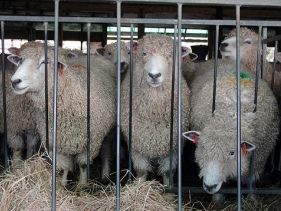Research: Sheep like flavour diversity, especially umami

Sheep given a variety of feed flavours will stop gorging and start eating more small meals over the course of the day, say researchers Juan Villalba (Utah State University, USA), Ignacio Ipharraguerre (Lucta SA, Spain) and Álex Bach (ICREA, Spain).
Their findings, published in the August 2011 issue of the Journal of Animal Science, could help livestock producers maximize feed intake and nutrient efficiency at the same time.
Villalba authored the paper “Feed behaviour and performance of lambs are influenced by flavour diversity”.
The studies were supported by grants from Lucta SA in Montornés del Vallés, Spain, and the USA-based Utah Agricultural Experiment Station.
Villalba, associate research professor of foraging behaviour in USU’s Department of Wildland Resources, says current sheep feeding practices usually provide animals with only one flavour of feed.
“This is like humans eating only hamburgers every day,” he says, “they get tired of eating that same flavour over and over.”
Savoury preference
In one part of the experiment, young sheep were given a choice of plain feed, sweet-flavoured feed, bitter-flavoured feed and umami-flavoured (savoury) feed. (Umani, which means “pleasant savoury taste” in Japanese, is the so-called “fifth basic taste” in the basic taste quintet that includes sweet, sour, bitter and salty.)
Though all the feed types in the study had the same nutritional value, the flavours were meant to indicate the presence of certain elements. Bitterness, for example, tastes like plant toxins, sweetness indicates a high-calorie feed and umami indicates high protein content.
The growing sheep disliked the bitter feed and favoured the umami feed. Previous studies that compared only plain feed and sweetened feed had shown that young sheep favour sweeter feed, but sweet feed wasn’t the most favourite in Villalba’s study.
He says it probably doesn’t indicate that sheep dislike sweet feed; they may just like umami feed more. “That reference for protein is more relevant to growing animals,” he says.
Variety improves intake
By measuring feed intake, the researchers discovered that offering a variety of food helps animals continue eating throughout the day.
Instead of gorging on one type of food at the very beginning of the feeding period, the animals switched between flavours and came back for more meals throughout the day.
Not only did this behaviour increase feed intake, it kept ruminal pH from fluctuating.
Stable pH is important, Villalba says, because an increase in acid from eating too much starchy feed can lead to damage of rumen and abscesses in the liver.
“You won’t find those peaks and valleys in pH that you typically see in animals fed in feedlots,” he says.
Better digestion
Pacing feed intake could also help animals process the nutrients more efficiently, Villalba says. Producers could apply these findings in their own flocks. He suggests mixing umami flavour into feed at different ratios.
“Producers do not need to increase feed rations,” he says. “Flavours can also satiate the animal, not just nutrition.”
The desire to eat a variety of flavours is actually an evolutionary advantage. In the wild, and in some pastures today, sheep encounter many kinds of plants. By eating different plants, Villalba says, sheep can get a variety of nutrients as well as minimize exposure to any plant-specific toxins.
“Ruminants didn’t evolve in an environment where they had just one food to eat all the time,” he says.
Villalba, Ipharraguerre and Bach noted that sheep given a variety of flavours at an early age were more willing to accept changes in feed later in life. This is good news, they say, for producers who want to switch feed types without reducing intake.











